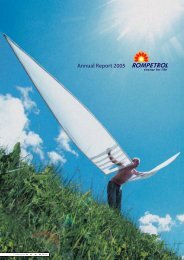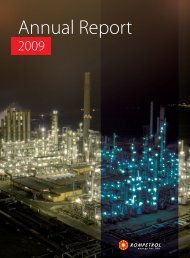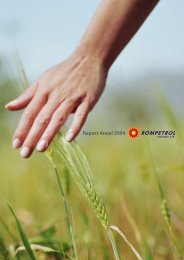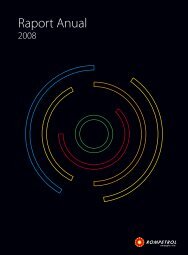1. Refining and Petrochemicals - Rompetrol.com
1. Refining and Petrochemicals - Rompetrol.com
1. Refining and Petrochemicals - Rompetrol.com
Create successful ePaper yourself
Turn your PDF publications into a flip-book with our unique Google optimized e-Paper software.
Business <strong>com</strong>binations are accounted for using the acquisition<br />
method. The cost of an acquisition is measured as the aggregate<br />
of the consideration transferred, measured at acquisition date<br />
fair value <strong>and</strong> the amount of any non-controlling interest in the<br />
acquiree. For each business <strong>com</strong>bination, the acquirer measures<br />
the non-controlling interest in the acquiree either at fair value<br />
or at the proportionate share of the acquiree’s identifiable net<br />
assets. Acquisition costs incurred are expensed <strong>and</strong> included<br />
in administrative expenses. Acquisitions of the non-controlling<br />
interests are considered as equity transactions.<br />
The Group’s investments in associates are accounted for using<br />
the equity method of accounting. Under the equity method,<br />
the investment in an associate is carried in the balance sheet at<br />
cost plus post acquisition changes in the Group’s share of net<br />
assets of the associate. After application of the equity method,<br />
the Group determines whether it is necessary to recognise an<br />
additional impairment loss on the Group’s investment in its<br />
associates.<br />
All intra-group balances, in<strong>com</strong>e <strong>and</strong> expenses <strong>and</strong> unrealised<br />
gains <strong>and</strong> losses resulting from intra-group transactions are<br />
eliminated in full.<br />
Goodwill is initially measured, at cost being the excess of the<br />
aggregate of the consideration transferred <strong>and</strong> the amount<br />
recognised for non-controlling interest over the net identifiable<br />
assets acquired <strong>and</strong> liabilities assumed. Goodwill is tested<br />
for impairment annually (as at December 31) <strong>and</strong> when<br />
circumstances indicate that the carrying value may be impaired.<br />
Property, plant <strong>and</strong> equipment are stated at cost, except for<br />
the <strong>Rompetrol</strong> Rafinare S.A., where the property, plant <strong>and</strong><br />
equipment are stated at revalued amounts, being the fair<br />
value less any accumulated depreciation <strong>and</strong> accumulated<br />
impairment loss.<br />
When assets are sold or retired, their cost <strong>and</strong> accumulated<br />
depreciation are eliminated from the accounts <strong>and</strong> any gain<br />
or loss resulting from their disposal is included in the in<strong>com</strong>e<br />
statement.<br />
Depreciation for property, plant <strong>and</strong> equipment, except l<strong>and</strong><br />
<strong>and</strong> construction in progress, is <strong>com</strong>puted using the straightline<br />
method over the following estimated useful lives, between<br />
3 to 60 years.<br />
At each balance sheet date the Group reviews the carrying<br />
amounts of its property, plant <strong>and</strong> equipment <strong>and</strong> intangible<br />
assets to determine whether there is any indication that those<br />
assets have suffered impairment. If such indication exists,<br />
the recoverable amount of the asset is estimated in order to<br />
determine the extent of the impairment loss (if any). Where<br />
it is not possible to estimate the recoverable amount of an<br />
individual asset, the Group estimates the recoverable amount of<br />
the cash-generating unit to which the asset belongs.<br />
Inventories, including work-in-process are stated at the lower<br />
of cost <strong>and</strong> net realisable value. Net realisable value is the<br />
selling price in the ordinary course of business, less the costs of<br />
Finance « <strong>Rompetrol</strong> Annual Report 2010 // 42<br />
<strong>com</strong>pletion, marketing <strong>and</strong> distribution. Cost <strong>com</strong>prises direct<br />
materials <strong>and</strong>, where applicable, direct labour costs <strong>and</strong> those<br />
overheads that have been incurred in bringing the inventories<br />
to their present location <strong>and</strong> condition. The following cost<br />
formulas were used to determine the cost applicable to different<br />
types of inventories:<br />
- The weighted average method for purchased crude oil <strong>and</strong><br />
petroleum products<br />
- The first-in-first-out (FIFO) for supplies <strong>and</strong> materials.<br />
Trade receivables are recognised initially at fair value <strong>and</strong><br />
subsequently measured at amortised cost using the effective<br />
interest method, less provision for impairment.<br />
Cash includes cash on h<strong>and</strong>, cash with banks <strong>and</strong> checks<br />
in course of being cashed. Cash equivalents are short-term,<br />
highly liquid investments that are readily convertible to known<br />
amounts of cash within the remaining three months or less to<br />
maturity from the date of acquisition <strong>and</strong> that are subject to an<br />
insignificant risk of change in value.<br />
Revenue is recognised to the extent that it is probable that the<br />
economic benefits will flow to the Group <strong>and</strong> the revenue can<br />
be reliably measured.<br />
Sales of goods are recognised when delivery has taken place<br />
<strong>and</strong> transfer of significant risks <strong>and</strong> rewards has been <strong>com</strong>pleted.<br />
Revenue <strong>com</strong>prises the fair value of the sale of goods <strong>and</strong><br />
services, net of value-added tax <strong>and</strong> any excise duties <strong>and</strong> other<br />
sales taxes, rebates <strong>and</strong> discounts.<br />
Revenue from rendering transportation services <strong>and</strong> other<br />
services is recognised when services are rendered.<br />
Payments to defined contribution retirement benefit plans are<br />
charged as an expense as they fall due. Payments made to state<br />
- managed retirement benefit schemes are dealt with as defined<br />
contribution plans where the Group’s obligations under the<br />
scheme are equivalent to those arising in a defined contribution<br />
retirement benefit plan.<br />
In<strong>com</strong>e tax charge consists of current <strong>and</strong> deferred taxes. The<br />
charge for the current tax is based on the results for the period<br />
as adjusted for non-deductible <strong>and</strong> non-taxable items. The tax<br />
rates <strong>and</strong> tax laws used to <strong>com</strong>pute the amount are those that<br />
are enacted or substantively enacted, by the reporting date, in<br />
the countries where the Group operates <strong>and</strong> generates taxable<br />
in<strong>com</strong>e.<br />
Deferred tax is provided using the liability method on temporary<br />
differences at the reporting date between the tax bases of assets<br />
<strong>and</strong> liabilities <strong>and</strong> their carrying amounts for financial reporting<br />
purposes.<br />
The Group determines the classification of its financial assets <strong>and</strong><br />
liabilities at initial recognition. Financial assets are recognised <strong>and</strong><br />
derecognised on a trade date where a purchase or sale of an<br />
investment is under a contract whose terms require delivery of<br />
the investment within the timeframe established by the market<br />
concerned <strong>and</strong> are initially measured at cost, including transaction<br />
costs.<br />
The Group’s financial assets include cash <strong>and</strong> cash equivalents,<br />
trade <strong>and</strong> other receivables, unquoted financial instruments,<br />
<strong>and</strong> derivative financial instruments. Financial liabilities<br />
include finance lease obligations, interest-bearing bank loans<br />
<strong>and</strong> overdrafts <strong>and</strong> trade <strong>and</strong> other payables <strong>and</strong> derivative<br />
financial instruments. For each item the accounting policies<br />
on recognition <strong>and</strong> measurement are disclosed in this note.<br />
Management believe that the estimated fair values of these<br />
instruments approximate their carrying amounts.<br />
Financial assets within the scope of IAS 39 are classified as<br />
financial assets at fair value through profit or loss, loans <strong>and</strong><br />
receivables, held to maturity investments, available-for-sale<br />
financial assets, or as derivatives designated as hedging<br />
instruments in an effective hedge, as appropriate. Financial<br />
liabilities within the scope of IAS 39 are classified as financial<br />
liabilities at fair value through profit <strong>and</strong> loss, loans <strong>and</strong><br />
borrowings, or as derivatives designated as hedging instruments<br />
in an effective hedge, as appropriate.<br />
RPT_2010 Annual Report_1024x768.indd 42 22/11/2011 10:35 AM


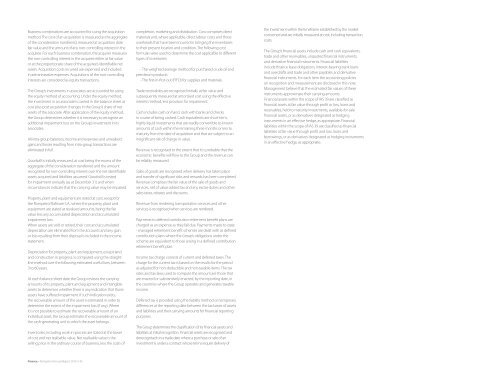

![Scrisoarea Directorului General de Opera]iuni - Rompetrol.com](https://img.yumpu.com/4907398/1/184x260/scrisoarea-directorului-general-de-operaiuni-rompetrolcom.jpg?quality=85)
